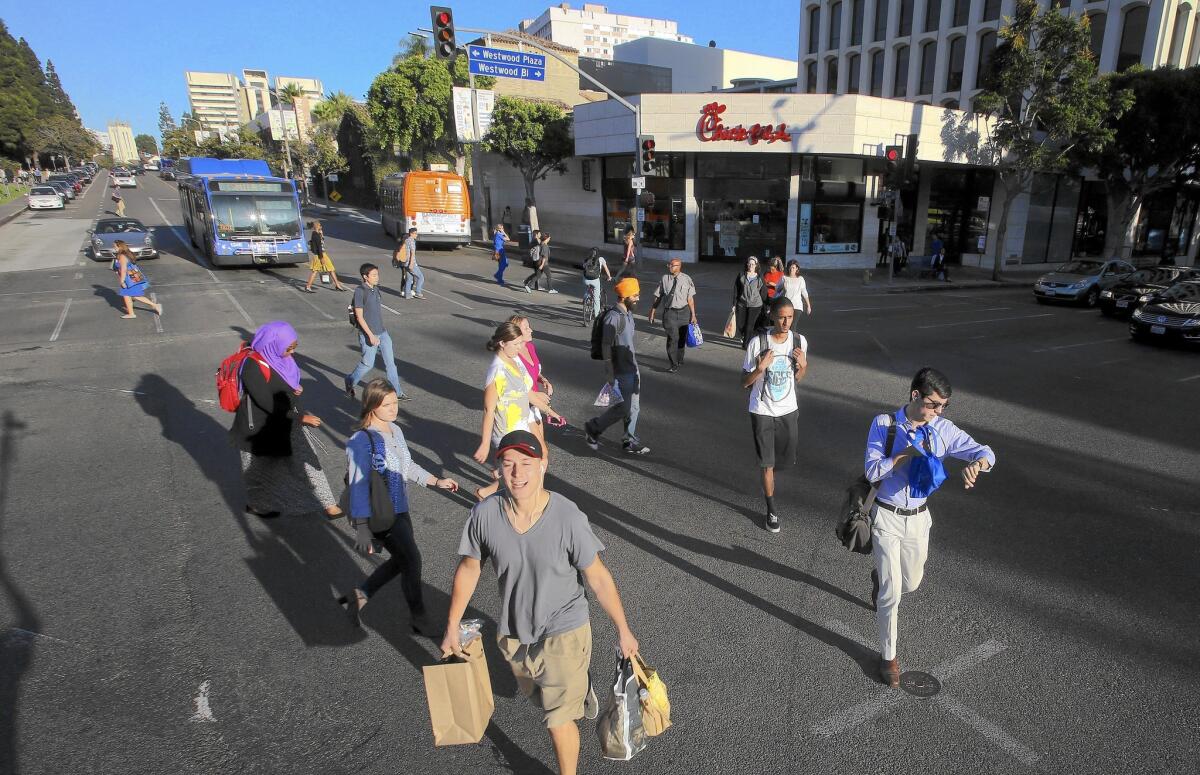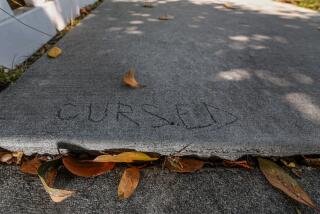Diagonal walkways put drivers, pedestrians at different cross purposes

Over the last decade, officials have tried a series of steps to rein in cars on Los Angeles streets.
They turned parking spaces into micro-parks, converted street corners into trendy plazas and reserved lanes of traffic for cyclists.
Now, Mayor Eric Garcetti is considering a controversial initiative designed to give pedestrians a leg up on motorists.
The city would install new crisscross, diagonal crosswalks, also known as pedestrian scrambles or, more colorfully, “Barnes dances,” for Henry Barnes, a traffic engineer who promoted their use in Denver 70 years ago. The special crosswalks require all vehicles to stop so that walkers can move freely corner to corner, including through the middle of an intersection.
Studies show they’re safer for pedestrians, but motorists find them annoying because they have to sit longer at red lights. Those extra wait times have led to recurring — and at times heated — debate in car-centric Los Angeles over whether scrambles are worth the trade-offs.
Garcetti wants to begin modestly, possibly converting three L.A. intersections near subway stations and gauging how they fit into street management, including the city’s carefully synchronized traffic lights.
Beverly Hills and Pasadena have several scrambles and declare them a success. The crosswalks make a powerful statement symbolically, experts say, because they give walkers greater parity with drivers in a city’s shared public space.
But Los Angeles City Councilman Mike Bonin, chair of the transportation committee, says it’s not clear that motorists or pedestrians benefit from the one diagonal crosswalk in his district. He said he’s seen backups of both at the Venice intersection.
Historically, that’s been the rub. Since the 1950s, Los Angeles has installed scrambles in bursts of pedestrian-friendly fervor, only to remove them when frustrated drivers and traffic managers complained about delays — or pedestrians got mixed up.
James E. Moore II, a USC engineering professor who studies transportation, said L.A.’s experience with these crosswalks reflects the difficulties that arise when policymakers try to reset the urban balance between motorists and pedestrians.
“You’ve got to keep the pedestrian alive — that’s a real priority for everybody,” he said. “But how inconvenient should we be able to make driving to urge people to walk instead?”
::
On a recent weekday evening downtown, as the rush-hour tempo picked up, Oswaldo Fermin walked along 7th Street to Flower Street on his way to work. The intersection, atop a three-level, underground subway station, is one of L.A.’s busiest pedestrian hubs — and on Garcetti’s list for a possible scramble.
Fermin, 38, who alternates between driving and taking the bus to work, likes the idea. At a traditional intersection, like 7th and Flower, frequent conflicts can develop between pedestrians and turning vehicles. Fermin says that’s why those on foot need their own protected time to cross the street, even if it means drivers must wait a little longer.
“You know L.A.,” he said. “They’ll be stuck in traffic no matter what.”
There are a handful of diagonal crosswalks in Los Angeles, including in Westwood near UCLA. Other cities, such as San Francisco, San Diego, New York and Denver, have some in commercial areas with heavy pedestrian traffic.
The safety benefits of scrambles are well-documented. Studies in Beverly Hills and Oakland found that potential collisions between pedestrians and vehicles dropped by roughly half after the special crosswalks were installed.
But diagonal crosswalks remain rare across the country, primarily because they create both real and perceived bottlenecks for motorists and pedestrians.
In San Diego, a scramble installed a decade ago in the tourist-filled Gaslamp Quarter initially made movements “basically worse for everyone,” said Duncan Hughes, a senior traffic engineer for the city. Pedestrian wait times at the crossings doubled, and the extra time given to pedestrians disrupted traffic signal coordination in the area, he said.
The city kept the crosswalk, partly because it benefits nearby businesses, but made modifications to reduce pedestrian waits. San Diego has no plans to add more scrambles, he said.
Some urban planners say diagonal crosswalks could win favor as central cities gentrify and a new generation of urban dwellers embraces walkable neighborhoods and greater use of public transit and cycling.
Millennials, in particular, “don’t want to spend time behind the wheel of the car,” said Sam Schwartz, a national traffic planning expert in New York. “They’ve sat in the back seat watching Ma and Pa argue, complain and scream at traffic, and that’s not the life they’re electing for themselves.”
In Schwartz’s view, the main objection to scrambles has become a selling point for cities. “It’s good to have slower traffic in these areas,” he said. “It’s a bit safer, it helps the businesses — it creates a sense of activity.” In that respect, some more congestion could be good for L.A.’s urban environment, he suggested.
That hasn’t been a winning argument in the past. In postwar L.A., when downtown remained a major regional retail, residential and business hub, the city installed 25 diagonal crosswalks. But after two years of complaints, City Hall abandoned the experiment. “It bogs down traffic,” one official told The Times.
In 1995, a city transportation engineer declared scrambles wouldn’t make sense in L.A. for the foreseeable future. Not only do city streets carry too much car traffic, he said, they’re also too wide, meaning pedestrians require too much time to cross the street.
As recently as 2008, former Mayor Antonio Villaraigosa promoted the revival of diagonal crosswalks, saying they would encourage public transit use and walking. Ten were put in — two north of the USC campus, two in Westwood Village, one in Venice, one in Woodland Hills and four in the Fashion District in downtown. Within two years, all four in the Fashion District were removed because of traffic delays. Pedestrians were also confused about when to walk, records show.
Garcetti is studying adding scrambles at 7th and Flower, Hollywood Boulevard and Highland Avenue, and Aliso and Alameda streets near Union Station.
The crosswalks set the right tone and would begin to tilt the L.A. streetscape in favor of walkability, the mayor said in a recent interview. “There’s a real awakening about this,” he said. No one expects people to abandon their cars, he added. “The question is: Are people ready to have a nice neighborhood to live in?”
Hasan Ikhrata, executive director of the Southern California Assn. of Governments, said diagonal crosswalks support livable neighborhoods by making it easier for people to walk to and from bus stops and subway stations. Strengthening connections to the public transit system is vital in L.A., he said, because “we’re not going to build any more freeways.”
Motorists benefit from scrambles in some instances too, experts say. In Pasadena, one of two installed in Old Town in the 1990s has helped relieve a regular backup of turning cars waiting for pedestrians to cross the street, said Bahman Janka, the city’s transportation administrator.
Any proposed expansion of diagonal crosswalks would require approval by the City Council, where it could face tough questions. His office said the mayor hasn’t set a goal for how many scrambles he might want to install.
Bonin said he needs to see convincing data that the crosswalks would improve pedestrian safety. Otherwise, he said, the city should focus on fixing sidewalks and making sure kids have safe walking routes to school.
“I want to spend more time and energy on stuff that I know has a clearer impact,” Bonin said.
Moore, the USC professor, said that unless there’s a serious pedestrian safety concern, scrambles typically aren’t worth undermining the effectiveness of coordinated traffic lights. He sees them more as a high-profile show of support for those on foot than a smart traffic management tool.
“If I was the mayor of a major U.S. city and I was trying to think of ways to demonstrate my commitment to walkability,” he said, “this is something that I’d try.”
Miriam Ortiz, a 32-year-old administrative assistant who lives downtown, recently stood on the curb waiting to cross Flower at 7th. She said she thinks L.A. remains too much a car town to back a system favoring pedestrians.
“Sure, there’s walking, there’s public transportation,” she said. “But people still want to get in their cars and go.”
Follow @skarlamangla on Twitter for more L.A. government news.
More to Read
Sign up for Essential California
The most important California stories and recommendations in your inbox every morning.
You may occasionally receive promotional content from the Los Angeles Times.











